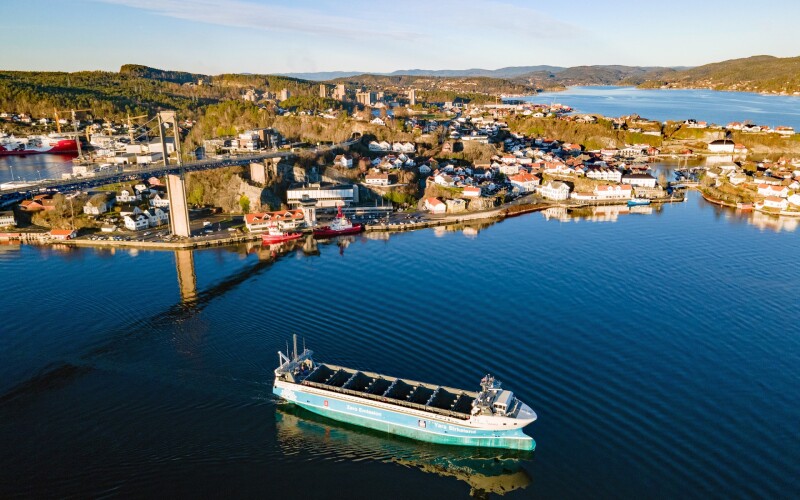According to a white paper published in 2021 by the American Bureau of Shipping, the International Maritime Organization has identified four degrees of vessel autonomy: (1) a ship with automated processes and decision support in which some operations may be automated and occasionally unsupervised but with seafarers on board ready to take control; (2) a remotely controlled ship with seafarers on board; (3) a remotely controlled ship without seafarers on board; and (4) a fully autonomous ship in which the vessel is able to make decisions and determine actions by itself.
A good example of category two is the Nellie Bly, a small tug built by Damen in Europe. Two years ago, the 36' tug circumnavigated Denmark navigating primarily by AI (artificial intelligence)-assisted machinery while being guided from Boston. The voyage was called the Machine Odyssey and the equipment that guided the tug was provided by Sea Machines. And even though the on-board machinery was almost constantly in control (96.7% of the time), while being guided and monitored by licensed U.S. mariners, there were also two live mariners on board the boat for “safety and redundancy,” according to Sea Machines.
The boat was named in honor of the female journalist who circumnavigated the globe in 72 days in 1889. This Nellie Bly’s trip was considerably shorter, about 1,000 nautical miles in 13 days, but the historical impact is similar, according to Michael G. Johnson, founder and CEO of Sea Machines.
“The completion of this voyage marks the catalyst for a new era of at-sea operations,” Johnson said in a statement. “Remotely commanded autonomous vessels provide the industry with significant increases in productivity and operational safety and will provide a new world of actionable operational data for improved planning and business practices.
The tug’s navigation was controlled by the company’s SM300 autonomy system, so named because it contains 300 main processors that integrate everything from radar, AIS and cameras to sensors that monitor the vessel’s pitch, roll and heave-to area charts. Waypoints and speed can be input in advance, as are collision avoidance parameters that trigger course and speed alterations. During the trip through Danish waters, the SM300 successfully executed 31 collision-avoidance situations and traffic separation maneuvers.
More recently, the SM300 system has been installed on a Foss Maritime tug, the Rachel Allen. In August 2022, the tug and its autonomous control system received approval from ABS following a process of new technology evaluation. ABS’s approval “moves our entire industry yet another step closer to widespread adoption of autonomous marine technologies,” said Sea Machine’s Johnson.
Foss project manager Dan Cole said that the SM300 system would be used to provide “additional crew and vessel safety through the enhanced situational awareness.” (In other words, an IMO category one operation.) Foss and Sea Machines have been working with the Coast Guard to get final approval for full operation.
Sea Machines and HamiltonJet have also teamed up to produce a voyage control system called JETsense. Using multiple sensors and artificial intelligence, JETsense can perceive the domain and maintain precise control of steering and speed while also avoiding traffic and obstacles. The new product was introduced at the 2021 International WorkBoat Show.
The development of autonomous vessel operations also continues to evolve in Europe. Fugro, a multinational company based in The Netherlands, recently completed what the company termed “the world’s first” fully remote inspection of offshore wind farms in the North Sea. The inspection was carried out by a 12-meter-long uncrewed surface vessel (USV) called Blue Essence with a Blue Volta, an electrical remotely operated vehicle (eROV). Fugro also deployed a Blue Essence USV in Australia for a remote inspection of three gas trunk lines.
In Norway, Yara International teamed up with the Kongsberg Group to build the world’s first autonomous and zero-emission container vessel, the Yara Birkeland. The 262' vessel has a cargo capacity of 120 TEUs and is powered by a 6.8-MWh battery bank. It will transport mineral fertilizer between Norwegian ports and replace 40,000 trips by diesel-powered trucks, thereby eliminating 1,000 tons of CO2 annually.
The ship is nearing the end of a two-year testing period.
Back in the U.S., the Navy continues to develop uncrewed surface vessels for a variety of missions. Bollinger Shipyards is building seven USVs that are designed to detect and destroy undersea mines. With options, the contract may grow to 20 additional vessels potentially worth $123 million for Bollinger.
In May, the Navy established the Unmanned Surface Vessel Division for the Pacific Fleet. It’s designed to be “the catalyst for innovation as we employ unmanned surface capabilities in the Pacific fleet,” Vice Adm. Roy Kitchener said in a statement. “The implementation of unmanned systems will increase decision speed and lethality to enhance our warfighting advantage.”
Saildrone, a U.S. USV fleet that now comes in three sizes, has just completed 10 years of operation during which the company’s boats have sailed over one million nautical miles, including circumnavigation of the Antarctic. Used for weather and oceanographic observations, the Saildrone Voyager design can also be deployed for law enforcement and maritime safety, drug interdiction, and border and harbor security.
With the rapid development of artificial intelligence, the growth of USVs is likely to continue. As Sea Machine’s Michael Johnson put it, “Autonomy is taking hold faster on the waterways that it is on the roadways.”




